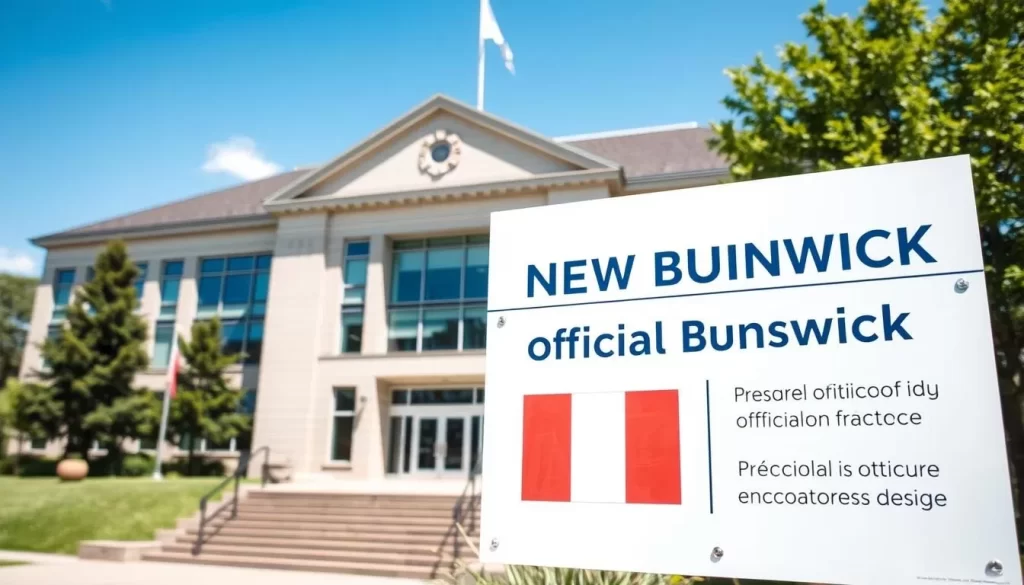✓ Accommodations ✓ Flights ✓ Rental Cars
Welcome to New Brunswick, a province where two languages, English and French, thrive side by side. This unique feature makes it stand out as the only officially bilingual region in the country. Here, both languages hold equal importance in government, education, and daily life.
With a population of over 775,000, the province is home to a vibrant mix of cultures and traditions. Cities like Fredericton, Moncton, and Saint John reflect this diversity, offering a blend of history and modernity. Whether you’re exploring government services or connecting with the community, understanding both languages is key.
This article will guide you through the historical roots, policies, and cultural dynamics that shape this bilingual province. Let’s dive in and discover why language diversity matters in New Brunswick.
Welcome to New Brunswick’s Linguistic Heritage
Step into a world where two languages shape daily life. This province is a unique blend of English and French, creating a vibrant cultural tapestry. Here, language isn’t just a tool for communication—it’s a cornerstone of identity and community.

An Overview of the Province’s Language Landscape
With a population of over 749,200, the region thrives on its bilingual foundation. Cities like Saint John showcase this duality, offering services and education in both languages. The government ensures that every resident has access to resources in their preferred tongue, fostering inclusivity.
Compared to neighboring areas like Nova Scotia, this province stands out for its commitment to balanced bilingualism. Schools and universities play a key role in preserving this heritage, teaching students the value of language diversity.
Why Language Diversity Matters to You
Understanding this linguistic landscape empowers you in daily interactions. Whether you’re accessing government services or engaging with the community, bilingualism opens doors. It’s not just about communication—it’s about connecting with a rich cultural history.
Language diversity also strengthens cultural identity. It brings people together, creating a sense of belonging. By embracing both English and French, you become part of a larger story, one that continues to evolve with each passing year.
Historical Evolution of Languages in New Brunswick
The roots of language in this province run deep, shaped by centuries of history. From indigenous traditions to colonial influences, the story of language here is a fascinating journey. Understanding this evolution helps you appreciate the bilingual identity of the region.

Indigenous Influences and Early Settlers
Long before European settlers arrived, the Mi’kmaq and Maliseet peoples called this region home. Their languages and cultures laid the foundation for the area’s linguistic diversity. These indigenous groups used language not just for communication but also to preserve their rich traditions and knowledge.
With the arrival of European settlers in the 1600s, the linguistic landscape began to shift. French-speaking Acadians established thriving communities, blending their language with local customs. This early interaction between indigenous and settler groups set the stage for the bilingual identity we see today.
The Acadian Legacy and Colonial Conflicts
The Acadian community played a pivotal role in shaping the language of the province. However, their story is marked by hardship, particularly during the Deportation of the Acadians in the mid-1700s. This event disrupted communities but also strengthened their resolve to preserve their linguistic heritage.
Colonial conflicts further influenced the region’s linguistic evolution. English and French settlers vied for dominance, leading to a unique blend of both languages. By the time of Confederation, the province had already established itself as a bilingual community.
| Year | Event | Impact on Language |
|---|---|---|
| 1600s | Arrival of Acadians | Introduction of French |
| 1755 | Deportation of the Acadians | Strengthened linguistic resilience |
| 1867 | Confederation | Formalized bilingual identity |
Today, the legacy of these historical events continues to influence the province. From schools to government services, the bilingual framework reflects a deep respect for the past. By understanding this history, you gain a richer appreciation for the language dynamics of the region.
New Brunswick, Canada: Official and widely spoken languages
Explore the bilingual heartbeat of this unique region. Here, English and French coexist as official languages, creating a dynamic cultural and administrative landscape. This legal framework ensures both languages thrive in government, education, and daily life.
The bilingual status is supported by robust policies. For example, government services are available in both languages, ensuring accessibility for all residents. This balance is particularly evident in cities like Saint John, where bilingualism is a way of life.
Statistics reveal the depth of this linguistic diversity. Over 34% of the population is bilingual, speaking both English and French fluently. This is significantly higher than the national average, showcasing the province’s commitment to bilingualism.
Language use in government services reflects this commitment. From public administration to education, both languages are equally prioritized. This approach fosters inclusivity and strengthens cultural identity.
Compared to other regions, this province stands out for its balanced language distribution. While English is more widely spoken, French retains a strong presence, particularly in education and cultural institutions.
Understanding this bilingual framework is key to navigating daily life here. Whether you’re accessing government services or engaging with the community, both languages play a vital role. This balance not only enhances communication but also enriches the cultural fabric of the region.
Understanding Official Language Policies
The 1969 Official Languages Act marked a turning point for bilingualism. This law ensured equal status for English and French in all governmental institutions. It was a significant step toward fostering inclusivity and respect for both languages.

The 1969 Official Languages Act Explained
The Act was designed to advance language rights through legislative means. It recognized the needs of linguistic minority communities and aimed to support their development. This law not only promoted equality but also strengthened cultural identity.
Federal institutions were required to create environments conducive to the use of both languages. This ensured that residents could access services in their preferred language. The Act’s principles continue to shape policies today.
Accessing Government Services in Both Languages
In this province, government services are available in English and French. This ensures accessibility for all residents, regardless of their primary language. From healthcare to education, bilingual services are a priority.
For example, federal courts must accommodate both languages without the need for interpreters. This policy fosters trust and improves communication between the government and its citizens.
Understanding these policies helps you navigate daily life with ease. Whether you’re accessing healthcare or legal services, bilingualism ensures you’re supported every step of the way.
Cultural Significance of English and French in the Province
In this province, language is more than words—it’s a bridge to cultural identity. Both English and French heritage have shaped the region’s traditions, festivals, and daily life. This bilingual legacy is celebrated in vibrant ways, making it a cornerstone of community pride.
Celebrating Bilingual Traditions
Local festivals honor the province’s dual heritage. Events like the Acadian Festival and the Frye Festival showcase music, art, and literature in both languages. These gatherings bring people together, fostering a sense of belonging and shared identity.
Educational institutions play a key role in preserving this heritage. Schools and universities offer programs that teach the value of bilingualism. Students learn to appreciate both languages, ensuring this tradition continues for future generations.
Families and neighborhoods also maintain a strong bilingual identity. Many households use both languages daily, creating a rich linguistic environment. This practice strengthens cultural ties and ensures the survival of both languages.
Emotional and Social Benefits
Being part of a bilingual community offers emotional and social advantages. It fosters inclusivity and understanding, allowing people to connect across linguistic barriers. This shared experience builds stronger relationships and a more cohesive society.
Cultural heritage continues to shape personal and community values. By embracing both languages, you become part of a larger story. This connection enriches your life and deepens your appreciation for the region’s history.
| Event | Description | Language Focus |
|---|---|---|
| Acadian Festival | Celebrates Acadian culture with music, food, and art | French |
| Frye Festival | Showcases literature and storytelling | English and French |
| Winter Carnival | Features bilingual performances and activities | English and French |
These events highlight the province’s commitment to bilingualism. They also provide opportunities for you to engage with the community and celebrate its linguistic diversity. To learn more about the cultural impact of bilingualism, explore language rights and their role in shaping identity.
Understanding the cultural significance of both languages helps you connect with the region’s heritage. Whether through festivals, education, or daily interactions, bilingualism is a vital part of life here. It’s not just about communication—it’s about celebrating a shared history and building a stronger future.
Economic and Immigration Insights into the Province
Discover why this province is a top choice for immigrants seeking new opportunities. With a thriving economy and welcoming community, it offers a unique blend of affordability and quality of life. Whether you’re a skilled worker or a family looking to relocate, this region has something for everyone.
The government supports economic growth through initiatives that attract businesses and create jobs. Programs like the New Brunswick Provincial Nominee Program (NBPNP) make it easier for skilled workers to settle here. These efforts have led to a steady increase in the population, with many immigrants finding success in various industries.
Immigration Programs and Opportunities for You
If you’re considering moving here, the NBPNP is a great place to start. This program targets skilled workers, entrepreneurs, and families, offering pathways to permanent residency. The process is straightforward, and the government provides resources to help you every step of the way.
Here’s what makes this province stand out:
- Affordable living costs: Compared to other regions, housing and daily expenses are more manageable.
- Job opportunities: Key sectors like healthcare, technology, and education are growing rapidly.
- Bilingual environment: English and French are both widely used, making it easier to adapt.
Many immigrants have successfully integrated into the community, finding fulfilling careers and building strong connections. For example, the New Brunswick immigration programs have helped thousands of skilled workers start new lives here.
To make the most of these opportunities, it’s essential to verify information with official government resources. This ensures you have accurate details about eligibility and application processes. With the right preparation, you can take the first step toward a brighter future in this welcoming province.
Language, Education, and Community Development
Education plays a pivotal role in shaping the bilingual identity of this region. Schools and universities are more than just learning centers—they are pillars of community development. Here, bilingual education is deeply rooted in the academic framework, fostering both English and French proficiency.
The Role of Universities and Local Schools
Institutions like the University of New Brunswick have a long history of promoting bilingualism. They offer programs designed to enhance language skills while connecting students to the region’s cultural heritage. These efforts ensure that graduates are well-prepared to contribute to the community.
Local schools also play a crucial role. Many have integrated bilingual curriculums that celebrate the province’s dual heritage. For example, students participate in projects that explore Acadian history and Francophone traditions. These initiatives strengthen cultural identity and foster inclusivity.
Government policies further support these efforts. The Official Languages Act ensures that educational institutions receive the resources needed to maintain bilingual programs. This commitment has led to an increase in bilingual enrollment across the province.
Community Development Through Education
Educational institutions often collaborate with local organizations to drive community development. For instance, schools partner with cultural centers to host events that celebrate both languages. These activities not only enrich students’ learning experiences but also bring the community together.
Success stories abound in this region. Many local schools have embraced language diversity, creating environments where students thrive. These achievements highlight the importance of bilingual education in shaping the province’s future.
If you’re planning to move here, navigating educational resources is straightforward. Schools and universities offer support services to help families transition smoothly. Whether you’re enrolling your child or pursuing higher education, you’ll find ample opportunities to engage with the bilingual community.
| Institution | Program | Impact |
|---|---|---|
| University of New Brunswick | Bilingual Studies | Prepares graduates for diverse careers |
| Local Schools | Cultural Heritage Projects | Strengthens community ties |
| Government | Official Languages Act | Supports bilingual education |
To learn more about how education underpins community development, explore the Action Plan for Official Languages. This initiative highlights the government’s commitment to strengthening bilingualism and supporting linguistic diversity.
Practical Tips for Adapting to New Brunswick’s Language Scene
Navigating daily life in a bilingual setting can be both rewarding and challenging. In this province, English and French coexist seamlessly, offering a unique cultural experience. Whether you’re new to the area or a long-time resident, these tips will help you adapt smoothly.
Daily Life and Cultural Navigation
Start by embracing the bilingual nature of the province. In cities like Moncton and Fredericton, you’ll find signs, menus, and services in both languages. This makes it easier to speak English or French confidently in any situation.
Local community centers often host language exchange programs. These are great for practicing your skills and meeting new people. Don’t hesitate to ask for help if you’re unsure—residents are generally welcoming and supportive.
Essential Language Resources and Services
The government provides numerous resources to assist you. Translation services are readily available for official documents and public services. This ensures you can access essential services without language barriers.
Language classes are another valuable tool. Many institutions offer courses tailored to beginners and advanced learners. These programs not only improve your language skills but also deepen your understanding of the local culture.
For more insights on language rights and policies, explore the Standing Senate Committee on Official Languages. This resource highlights ongoing efforts to support bilingualism in the province.
Living in a bilingual province like this one enriches your experience. With these practical tips, you’ll feel more confident navigating daily life and connecting with the community.
Conclusion
New Brunswick stands as a shining example of bilingual harmony in North America. Its unique blend of English and French cultures creates a vibrant society where both languages thrive. From government services to education, the province ensures accessibility for all residents.
Understanding the historical roots and policies behind this bilingualism enriches your experience. Cities like Saint John showcase this duality, offering a glimpse into the region’s cultural richness. The commitment to language equality fosters inclusivity and strengthens community bonds.
Whether you’re exploring opportunities in education, immigration, or cultural enrichment, this province welcomes you. Dive deeper into its language policies and community initiatives to fully appreciate its legacy. For more insights, explore the language situation in New Brunswick.
Thank you for joining us on this journey. We hope this guide inspires you to engage further with this remarkable region.
The above is subject to change.
Check back often to TRAVEL.COM for the latest travel tips and deals.






